阅读理解之事实细节题
- 格式:ppt
- 大小:737.50 KB
- 文档页数:21

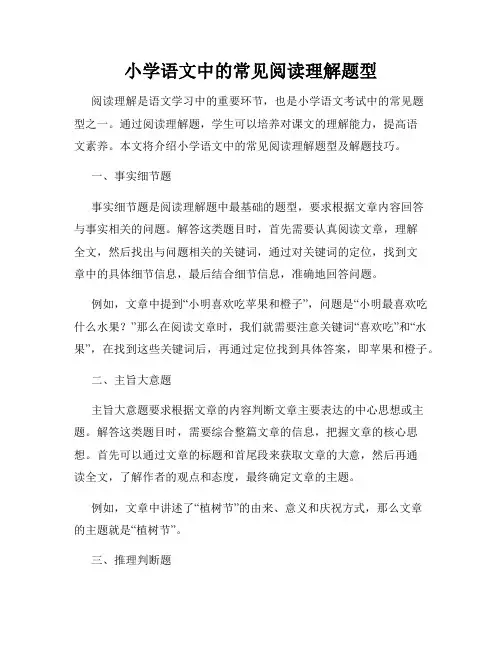
小学语文中的常见阅读理解题型阅读理解是语文学习中的重要环节,也是小学语文考试中的常见题型之一。
通过阅读理解题,学生可以培养对课文的理解能力,提高语文素养。
本文将介绍小学语文中的常见阅读理解题型及解题技巧。
一、事实细节题事实细节题是阅读理解题中最基础的题型,要求根据文章内容回答与事实相关的问题。
解答这类题目时,首先需要认真阅读文章,理解全文,然后找出与问题相关的关键词,通过对关键词的定位,找到文章中的具体细节信息,最后结合细节信息,准确地回答问题。
例如,文章中提到“小明喜欢吃苹果和橙子”,问题是“小明最喜欢吃什么水果?”那么在阅读文章时,我们就需要注意关键词“喜欢吃”和“水果”,在找到这些关键词后,再通过定位找到具体答案,即苹果和橙子。
二、主旨大意题主旨大意题要求根据文章的内容判断文章主要表达的中心思想或主题。
解答这类题目时,需要综合整篇文章的信息,把握文章的核心思想。
首先可以通过文章的标题和首尾段来获取文章的大意,然后再通读全文,了解作者的观点和态度,最终确定文章的主题。
例如,文章中讲述了“植树节”的由来、意义和庆祝方式,那么文章的主题就是“植树节”。
三、推理判断题推理判断题是要求根据文章中的已知信息进行推理,从而做出判断。
解答这类题目时,需要运用自己的逻辑思维能力,结合文章中的信息进行推断。
在推理判断过程中,需要注意避免主观臆断,要根据文章的逻辑关系进行推断。
例如,文章提到“天气预报说明天可能下雨”,问题是“明天小明一定会带伞吗?”那么我们可以根据天气预报的信息推断,小明可能会带伞,但不一定会带。
因为可能有其他原因使他不带伞。
四、归纳概括题归纳概括题是要求根据文章的内容总结出一个概括性的结论。
解答这类题目时,需要综合考虑文章中的各种细节信息,找出它们之间的联系,并将其概括成一个简洁明了的句子。
例如,文章中提到了小明的爱好有阅读、音乐和运动,问题是“小明的兴趣爱好是什么?”那么我们可以将这些细节概括成“小明的兴趣爱好多样化,包括阅读、音乐和运动”。

阅读理解之“细节理解”题解题指导细节理解题是指原文提到了某事实、现象或理论,而题干则针对原文的具体叙述设问,属于浅层次的理解题,难度较低,但在中考中却占有很大比重。
同学们解答细节题时,需要在有限的时间内运用略读、扫读、跳读等技巧快速阅读,发现文章中的细节信息,然后遵循由整体到细节的原则,把握作者的思路,按全文—段落—词语的步骤来解题。
一、命题特点事实细节题的考点非常明确,考点通常集中在以下几处:1.列举信息。
文章中first, second, to begin with, in addition, on one hand, on the other hand等并列关系出现的地方,常会要求考生从所列的内容中选择符合题干要求的选项。
2.举例与打比方。
要注意那些引出例子或比喻的标志词,如as, such as, for example, for instance 等,用于引出具体事实,使文章观点更具说服力。
这些事例就是常考的细节之处。
3.指示代词出现。
这类考题常用来考查学生是否真正了解上下文句子之间的逻辑关系。
4.引用人物论断。
作者为使论点更有依据,常会引用某些权威人士的论断或采纳其重要的发现。
5.特殊标点符号后的内容。
因为特殊标点符号后的内容往往是对前面内容的进一步解释或说明,因此,注意到这些标点,也就注意到了细节。
这些特殊符号包括表示解释的破折号、括号和冒号以及表示引用的引号等。
另外,细节理解题的选项也很有特点:通常正确答案不是照搬的原文。
而干扰选项则正好相反,有的来自原文信息,但不是题目要求的内容;有的符合常识,但不符合原文内容;有的与原句内容极为相似,是在程度上有些变动;有的与原文大相径庭甚至完全相反;也有的是部分正确或部分错误。
二、解题方法1.跳读查找法。
这个方法的要点在于先看题干,然后带着问题读文章。
以what, who, where, when, why, how 提问的问题,可以从文章中直接找到答案。
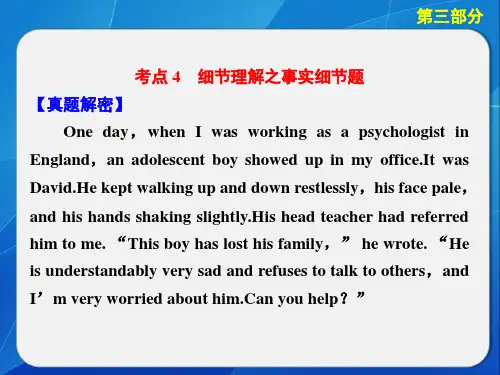

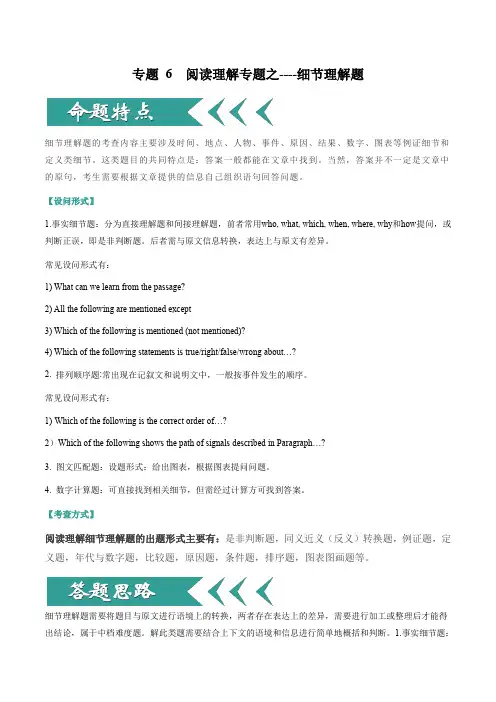
专题 6 阅读理解专题之----细节理解题细节理解题的考查内容主要涉及时间、地点、人物、事件、原因、结果、数字、图表等例证细节和定义类细节。
这类题目的共同特点是:答案一般都能在文章中找到。
当然,答案并不一定是文章中的原句,考生需要根据文章提供的信息自己组织语句回答问题。
【设问形式】1.事实细节题:分为直接理解题和间接理解题,前者常用who, what, which, when, where, why和how提问,或判断正误,即是非判断题。
后者需与原文信息转换,表达上与原文有差异。
常见设问形式有:1) What can we learn from the passage?2) All the following are mentioned except3) Which of the following is mentioned (not mentioned)?4) Which of the following statements is true/right/false/wrong about…?2. 排列顺序题:常出现在记叙文和说明文中,一般按事件发生的顺序。
常见设问形式有:1)Wh ich of the following is the correct order of…?2)Which of the following shows the path of signals described in Paragraph…?3. 图文匹配题:设题形式:给出图表,根据图表提问问题。
4. 数字计算题:可直接找到相关细节,但需经过计算方可找到答案。
【考查方式】阅读理解细节理解题的出题形式主要有:是非判断题,同义近义(反义)转换题,例证题,定义题,年代与数字题,比较题,原因题,条件题,排序题,图表图画题等。
细节理解题需要将题目与原文进行语境上的转换,两者存在表达上的差异,需要进行加工或整理后才能得出结论,属于中档难度题。

阅读理解专项练习题一、事实细节题1. 请从文中找出作者提到的我国著名旅游景点。
2. 根据文章内容,简要描述主人公在困境中是如何自救的。
3. 文中提到的科技创新成果有哪些?4. 请列举出文中提到的几种环保措施。
5. 从文章中可以看出,作者对传统文化的态度是怎样的?二、词义猜测题1. 根据上下文,推测“瓶颈”一词在文中的含义。
2. “这片土地见证了历史的沧桑”中的“沧桑”是什么意思?3. 文中提到的“绿色出行”,请你猜测一下它的含义。
4. “他这个人很轴”中的“轴”字在这里是什么意思?5. 请解释“与时俱进”在文中的具体含义。
三、推理判断题A. 主人公最终克服了困难B. 文章主要讲述了我国的历史变迁C. 作者对现代科技持否定态度D. 文章倡导人们保护环境A. 我国旅游资源丰富B. 主人公在困境中得到了他人的帮助C. 科技创新对国家发展至关重要D. 作者认为传统文化需要传承和发扬A. 文章旨在表达对大自然的赞美B. 主人公在故事中经历了成长C. 环保意识在现代社会越来越受到重视D. 作者认为传统文化已经过时四、主旨大意题1. 请简要概括文章的主题。
2. 文章主要从哪几个方面论述了科技创新的重要性?3. 请用一句话概括文章的中心思想。
五、观点态度题1. 作者在文中对环境保护的态度是怎样的?2. 从文章中可以看出,作者对主人公的遭遇持何种态度?3. 请分析作者对传统文化的观点。
六、信息筛选题A. 旅游B. 自救C. 科技创新D. 环保E. 传统文化2. 请筛选出文中关于我国经济发展的相关内容。
七、句子理解题1. “教育的本质不是灌输,而是点燃火焰。
”这句话在文中的含义是什么?2. 文中提到的“这是一场没有硝烟的战争”,这句话是如何体现文章主题的?3. 请解释“时间就像海绵里的水,只要愿挤,总还是有的”这句话在文中的意义。
八、段落作用题1. 请分析第二段在文中的作用。
3. 第三段与第四段之间有什么联系?请简要说明。
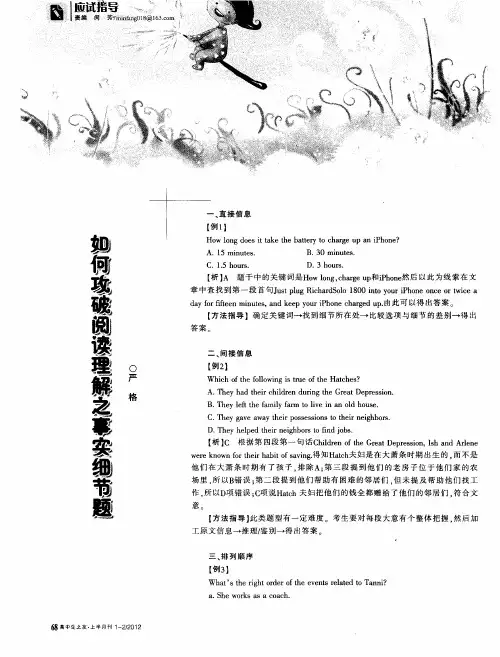
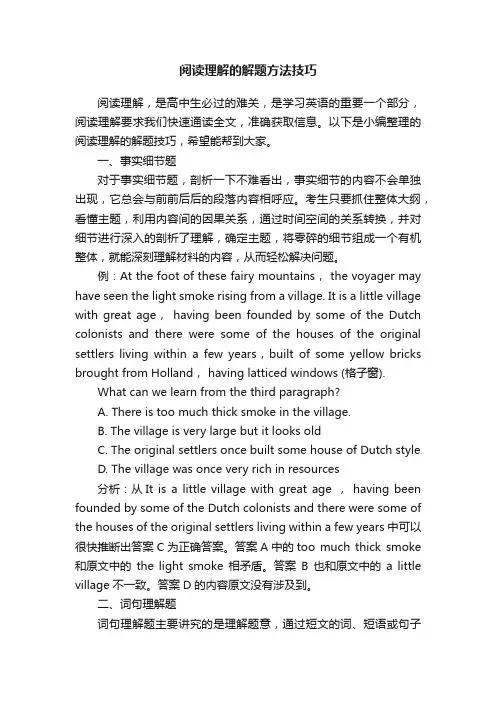
阅读理解的解题方法技巧阅读理解,是高中生必过的难关,是学习英语的重要一个部分,阅读理解要求我们快速通读全文,准确获取信息。
以下是小编整理的阅读理解的解题技巧,希望能帮到大家。
一、事实细节题对于事实细节题,剖析一下不难看出,事实细节的内容不会单独出现,它总会与前前后后的段落内容相呼应。
考生只要抓住整体大纲,看懂主题,利用内容间的因果关系,通过时间空间的关系转换,并对细节进行深入的剖析了理解,确定主题,将零碎的细节组成一个有机整体,就能深刻理解材料的内容,从而轻松解决问题。
例:At the foot of these fairy mountains, the voyager may have seen the light smoke rising from a village. It is a little village with great age,having been founded by some of the Dutch colonists and there were some of the houses of the original settlers living within a few years,built of some yellow bricks brought from Holland, having latticed windows (格子窗).What can we learn from the third paragraph?A. There is too much thick smoke in the village.B. The village is very large but it looks oldC. The original settlers once built some house of Dutch styleD. The village was once very rich in resources分析:从It is a little village with great age ,having been founded by some of the Dutch colonists and there were some of the houses of the original settlers living within a few years中可以很快推断出答案C为正确答案。
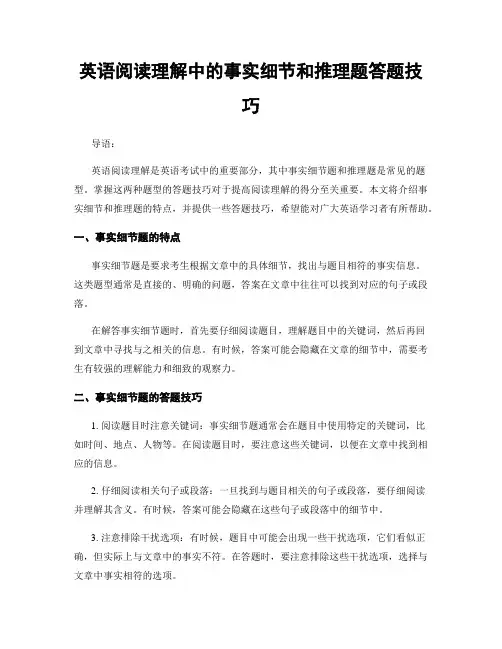
英语阅读理解中的事实细节和推理题答题技巧导语:英语阅读理解是英语考试中的重要部分,其中事实细节题和推理题是常见的题型。
掌握这两种题型的答题技巧对于提高阅读理解的得分至关重要。
本文将介绍事实细节和推理题的特点,并提供一些答题技巧,希望能对广大英语学习者有所帮助。
一、事实细节题的特点事实细节题是要求考生根据文章中的具体细节,找出与题目相符的事实信息。
这类题型通常是直接的、明确的问题,答案在文章中往往可以找到对应的句子或段落。
在解答事实细节题时,首先要仔细阅读题目,理解题目中的关键词,然后再回到文章中寻找与之相关的信息。
有时候,答案可能会隐藏在文章的细节中,需要考生有较强的理解能力和细致的观察力。
二、事实细节题的答题技巧1. 阅读题目时注意关键词:事实细节题通常会在题目中使用特定的关键词,比如时间、地点、人物等。
在阅读题目时,要注意这些关键词,以便在文章中找到相应的信息。
2. 仔细阅读相关句子或段落:一旦找到与题目相关的句子或段落,要仔细阅读并理解其含义。
有时候,答案可能会隐藏在这些句子或段落中的细节中。
3. 注意排除干扰选项:有时候,题目中可能会出现一些干扰选项,它们看似正确,但实际上与文章中的事实不符。
在答题时,要注意排除这些干扰选项,选择与文章中事实相符的选项。
三、推理题的特点推理题是要求考生根据文章中的暗示和线索,进行推理和判断,找出与文章相符的答案。
这类题型通常是间接的、隐含的问题,答案需要考生根据文章的信息进行推理和判断。
在解答推理题时,考生需要理解文章的主旨和作者的意图,并根据文章中的线索进行推理。
推理题需要考生具备较强的逻辑思维能力和阅读理解能力。
四、推理题的答题技巧1. 理解文章的主旨和作者的意图:在解答推理题之前,要先理解文章的主旨和作者的意图。
这样可以帮助考生更好地把握文章的信息,进行正确的推理和判断。
2. 注意文章中的线索和暗示:推理题的答案往往需要考生根据文章中的线索和暗示进行推理。
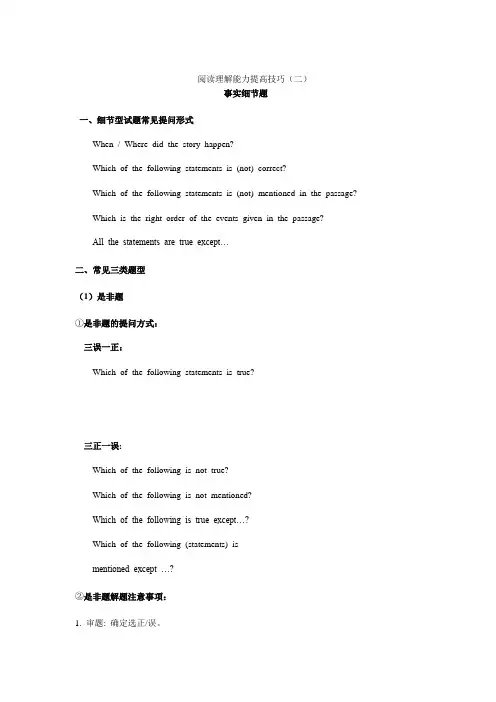
阅读理解能力提高技巧(二)事实细节题一、细节型试题常见提问形式When / Where did the story happen?Which of the following statements is (not) correct?Which of the following statements is (not) mentioned in the passage?Which is the right order of the events given in the passage?All the statements are true except…二、常见三类题型(1)是非题①是非题的提问方式:三误一正:Which of the following statements is true?三正一误:Which of the following is not true?Which of the following is not mentioned?Which of the following is true except…?Which of the following (statements) ismentioned except …?②是非题解题注意事项:1. 审题: 确定选正/误。
2. 定位:查找原文中与选项内容相关的词句3. 三误一正:对原文同义表达的为正确答案.如果定位困难,可以运用排除法,这样找到答案的可能性就会增加。
4.为节省时间,通常找到答案就不再考虑其他选项。
Food sometimes gets poisoned with harmful things. A person who eats such food can g et an illness called food poisoning. Food poisoning is usually not serious, but some types are deadly. The symptoms of food poisoning usually begin within hours of eating the p oisoned food. Fever isone of the most common symptoms.Which of the following statements is NOT true?A. Food when poisoned can make people sick.B. Food poisoning means death.C. Food poisoning comes in varieties.D. Food poisoning can be serious.(2)年代数字考点题年代数字考点解题注意事项:不管考点以何种形式出现,只要问年代与数字,答案就对应于文章中的年代和数字,一般会涉及简单运算。
事实细节题型阅读解题技巧题型介绍阅读理解题是高考备考的“重头戏”,因为它占到了40分,是全卷分值最大的一道题。
高考阅读理解选题体裁多样,涉及记叙文、说明文、应用文和议论文;选材新颖,贴近生活,强调跨文化意识和能力,强调语篇选材的真实性;话题广泛,涉及政治、经济、历史、地理、文化、教育、新闻报道、人物故事、科技信息、海外风情等;题型合理,在题型设计上,包括词义猜测题、细节理解题、推理判断题、主旨大意题、和意图态度题等几大题型。
考纲要求“理解文中具体信息”,细节理解题正是对文中具体信息的掌握情况进行考查,是高考英语阅读理解中占比重最大的一类题型,在2017年全国新课标卷的阅读理解20道小题中占到一半(10题)。
这类题旨在考查考生对事实细节的理解。
主要针对who, what, which, why, how, when, where等来提问。
细节题的命题方法很多,如可能是对某个细节用同义结构转换后进行考查,也可能是将文章中的几个细节(通常是四个)放在一起要求考生判断是非(选出正确的一项或选出错误的一项)或对几个细节进行排序等。
解答这类试题时,一个常用的方法就是运用定位法,即根据题干或选项中的线索词从原文中找到相关的句子,与选项进行比较从而确定答案(此时要特别注意一些常见的同义转换)。
解题技巧设问特点常以when, where, what, which, who, how much/many等词提问。
以是非true /false, not true / false或EXCEPT等词提问。
正确选项的特点正确选项一般都会在原文基础上进行改造。
常用方法就是同义词替换或释义,即把文中语言(词汇和结构)改头换面,来表达相同的意思。
干扰项特征1)无中生有:凭空捏造原文不存在的细节,以迷惑和干扰考生。
2)常识干扰:干扰项是一些基本常识和我们对社会、生活等方面一些问题的一般看法和认识,虽然符合客观现实,但并非文章所提及的。
高中英语阅读理解事实细节题篇一:高一英语阅读理解事实细节专练高一英语阅读理解.一. 理解事实细节.(1)A doctor was once teaching a class of medical students at a famous hospital in Edinburgh. An injured man was brought in, and the doctor turned to one of the students and asked him, ―What‘s wrong with this man?‖― I don‘t know, sir ― the student answered. ― Shall I examine him and find out?‖― There‘s no need to examine him‖, said the doctor, ―You should know without asking questions. He has hurt his right knee. Didn‘t you notice the way he walked ? He hurt it by burning it in the fire. You see his trouser leg is burnt away at the knee. This is Monday morning. Yesterday was fine, but on Saturday the roads were wet and muddy. The man‘s trousers are muddy all over. The man fell down on Saturday night.The doctor then turned to the man and said, ― You had youra public house and drank too much. You got wet and muddy on the way home. Because you had drunk too much, you fell on the fire and burnt your knee. Is thatright ?‖―Yes, sir.‖ said the man.1. The medical students were having a lesson______________.A. in a classroomB. at the libraryC. at a well-known hospitalD. a medical school2. The man hurt his knee_______________.A. on Saturday nightB. yesterdayC. on Monday morningD. on Friday night3. The man burnt his knee _______________.A. when he was on his way to the hospitalB. because he had drank too much and fell on the fireC. because he was coldD. because he was ill4. WAGE in the fourth paragraph means_______________.A. holidayB. money paid every weekC. carsD. servants5. The doctor was good at _______________.A. learning from othersB. taking care of othersC. watching and thinkingD. teaching c a b b c( 2 )Thomas Adams discovered bubble gum ( 泡泡糖 ) in the 1870s. He was an American. He wanted to find a usefor chicle(糖胶树胶). Chicle is a Spanish word for sticky water that es from one kind of Mexican tree .Mr Adams wanted to make rubber from chicle.Mr Adams worked in his home while he tried to find a way to make the chicle stronger. Hisson, Horatio, also helped him now and then.One day, young Horatio began to chew the chicle while he watched his father work. It did not taste very good, but Horatio enjoyed chewing it. Then the young boy began to blow bubbles with the new chicle which his father had made. Mr Adams had discovered bubble gum by accident.Mr Adams gave up trying to find a way to make rubber from chicle. Instead , he wanted to try and sell the new gum that he had made. He thought other peoplemight like the taste too. He began to see his new kind of chicle as candy. In no time, children everywhere began chewing bubble gum.1. Where was Thomas Adams from ?A. CanadaB. The United StatesC. EuropeD. England2. Who was Horatio Adams?A. Thomas's fatherB. Thomas's wifeC. Thomas's brotherD. Thomas's son3. What was Thomas Adams trying to make ?A. A new kind of rubber .B. A new kind of chicle.C. A new kind of candy.D. Electric light.4. Why did Thomas Adams want to sell bubble gum ?A. His son enjoyed chewing it .B. He thought many people would like it.C. He could not make strong rubber from chicle.D. all of above5. Which of these sentences is not true?A. Horatio helped his father.B. Thomas Adams made rubber from chicle by accident.C. Horatio was the first person to chew bubble gum.D. Thomas Adams never made rubber. Bdadb(3)You can see a bell tower that leans (倾斜 ) in the town of Pisa, Italy. What does it lean against ? Nothing. It's called the Leaning Tower of Pisa, andit's been leaning more ever since it was built about 700 years ago. Some say that long ago the great Italian scientist Galileo dropped weights from the tower to learn how fast things fall. Even then , the tower was a leaning tower.And today , little by little, one side of the tower keeps on sinking into the soft ground. The LeaningTower tips (倾斜 ) about an inch every nine years. The farther it leans out of line, the faster it tips.You can climb stairs to the top of the tower and see the bells that once called people to a nearby church. But no one rings the bell now. The clang(铿锵声 ) might make the tower fall faster.The government of Italy once offered a prize for the best plan to keep the tower from falling any farther. Some people have ideas, but nothing has been done yet. If the Leaning Tower ever falls, it will be the end of what some people say is one of the seven wonders of the modern world.1. The Leaning Tower ___________.A. because famous right after it was builtB. leans against towerC. was built about seven centuries agoD. no longer tips today2. What do you know about Galileo?A. He was a great physicist who built the Tower.B. He was well known for designing the Tower.C. He drew a very famous experiment on the Tower.D. He designed a good plan to adjust the Tower.3. Nobody rings the bells in the Tower nowbecause_______________.A. there is something wrong with the bellsB. people in the town are annoyed by the ringing bells.C. nobody needs to be called to the churchD. the clang might make the Tower tip faster4. Which of the followings is NOT mentioned in the passage?A. The reason why the Leaning Tower is leaning.B. The condition of the Leaning TowerC. The plans that people offer to prevent the Tower from leaning.D. The measures that the government has taken to keep the Tower from falling.5. We can learn from the passage that _______________.A. people like the Leaning Tower so they have done nothing to keep it from leaningB. it is very difficult to stop the tower from leaningC. even if the Tower falls , the seven wonders will still existD.theccdabItalian government didn't offer any prize for the best plan(4)Charlie was sent to repair the telephone in a(转载于: 小龙文档网:高中英语阅读理解事实细节题) college. He stopped his car outside the gate and walked through a wide boulevard while a professor and his students were standing around the college flagpole in front of the teaching building. He stopped to watch what they were doing there." We need to know how high the flagpole is," said the professor to his students ." Who has a better way to calculate it ?"them all. Charlie began to laugh and came up to the flagpole .'"Watch!" said the young man. He laid the flagpole on the ground and measured it with a tape and then said, " Exactly 15.12 meters." Then he replaced the pole and walked away." What a silly idea!" the professor said angrily ." We wonder how height it is. But he gave us the length!"1. Charlie was a _____________.A. teacherB. professorC. repair manD. postman2. Charlie went to the college____________.A. by busB. on footC. by bikeD. by car3. The professor was going to ___________.A. put the flagpole downB. teach his students to calculate the flagpole's heightC. make a new flagpoleD. show his students how to measure the flagpole4. The underlined word "negated" means___________.A. encourageB. not agreeC. praiseD. know5.Charlie laughed because____________.A. he was good with mathB. he thought the professor was sillyC. he could easily know the flagpole's heightD.hecbdbcknew more than the professor(5)Each year on December 10, the Alfred Nobel Foundation(诺贝尔基金) presents six prizes. These prizes are named after Alfred Nobel, the man who invented dynamite(火药). It was Mr Nobel ?s idea to create(创造)the prizes. During his life, Mr Nobel made a lot of money from his invention. He put his money in a bank, and the money earned more money through interest(利息) from the bank. The money grew to be a very large amount.Mr Nobel decided to use his money to help scientists, artists, and people who worked to help others around the world. He created the Nobel Prizes to do this.The prizes set up by Mr Noble include physics, medicine, chemistry, literature, and peace.These five Nobel Prizes were first given out in 1901. Later, the Central Bank of Sweden(瑞典) made the Alfred Nobel Memorial Prize in Economic(经济) Science in1968 to celebrate(庆祝) the bank‘s 300th year of business.All of the prizes are handed out in Stockholm(斯德哥尔摩) except for the Peace Prize, which is presented in Oslo(奥斯陆).Each person who receives a Nobel Prize is given a cash prize, a medal, and a special paper which explains the prize the person won. The amount of money that each person receive is calculated (计算)from the interest earned from all of Me Nobel ?s money which is still in the bank.. This interest is divided equally betweenthe five prize winners in physics, medicine, chemistry, literature, and peace. The Central Bank of Sweden then pays an equal amount to the winner of the prize in Economics.1. The Nobel Prizes are presented ________A. at different timeB. In DecemberC. Every two yearsD. Every six years2. The main idea of the second paragraph is _____A. how many prizes Mr Nobel set upB. why Nobel Prize was createdC. what each prize winner will receiveD. where the prizes were presented3. Mr Nobel set up ______prizes at first.A. 5B. 6C. 7D. we don‘t know4. The Nobel Prize of ______are made and paid by Central Bank of Sweden.A. EconomicsB. MedicineC. LiteratureD. Physics5. The winners of the Nobel Prize will receive these except_______A. A medalB. MoneyC. An inventionD. A special paperKeys are : B B A A C篇二:高中英语阅读理解方法之细节题的解题技巧英语阅读理解---事实细节题的解题技巧所谓细节题,是指原文提到了某事物、现象或理论,题干针对原文具体叙述本身发问。
四六级阅读理解常见题型解析阅读理解题是大学英语四六级考试中的重要部分,考察考生对文章的理解和推理能力。
本文将针对四六级阅读理解常见题型进行解析,帮助考生提升解题技巧和答题效率。
一、事实细节题事实细节题主要考查考生对于文章中具体事实或细节的把握能力。
解答这类题目时,首先要仔细阅读相关段落,找出与题目相关的信息,然后进行准确匹配。
解题步骤:1. 仔细阅读题目,找出关键词或信息。
2. 阅读文章,寻找与关键词或信息相关的句子或段落。
3. 将找到的句子或段落与题目进行核对,选出正确答案。
例题:According to the passage, what do trees represent in Chinese culture?A. Beauty and strength.B. Power and control.C. Longevity and stability.D. Vitality and growth.解答步骤:1. 关键词:trees, represent, Chinese culture。
2. 阅读文章,寻找与关键词相关的句子或段落。
3. 找到相关句子:"In Chinese culture, trees symbolize longevity, stability, and growth."4. 核对答案,选出正确选项:C. Longevity and stability.二、推理判断题推理判断题主要考查考生根据文章中的线索进行推理和判断的能力。
解答这类题目时,需要准确把握关键信息,并根据上下文进行逻辑推理。
解题步骤:1. 仔细阅读题目,找出问题所在。
2. 阅读相关段落,寻找线索。
3. 根据线索进行推理和判断。
4. 核对答案,选出正确选项。
例题:What can be inferred from the passage?A. Pollution is the main cause of climate change.B. Climate change affects only wildlife.C. The Earth's temperature has been rising for decades.D. The government is taking effective measures to combat climate change.解答步骤:1. 关键词:inferred, passage。
阅读理解中的事实细节题解析阅读理解是英语考试中常见的题型之一,其中事实细节题是其中的一种类型。
在解答事实细节题时,我们需要准确找到文章中的具体信息,这就要求我们提高阅读理解和信息定位的能力。
下面将对事实细节题的解题技巧进行分析和解析,以帮助大家更好地应对这一题型。
一、什么是事实细节题事实细节题要求根据文章提供的信息,找出与问题相对应的准确事实细节。
在解答这类问题时,我们需要仔细阅读题干和文章,识别关键词,并通过排除干扰选项找到正确答案。
二、解题技巧1. 注意细节词在阅读文章时,应该留意一些具体的细节词,例如时间、地点、数字、人物等。
这些词语在问题中也可能会出现,通过将其对应起来可以快速找到正确答案。
2. 使用排除法在选项中,有时会出现一些易于排除的干扰选项。
通过排除干扰选项,可以缩小答案的范围,提高准确率。
3. 注意文章的逻辑结构通常情况下,文章的各个部分之间是有一定逻辑关系的。
在解答事实细节题时,可以通过理解文章的逻辑结构来判断答案的位置,从而更快地定位到正确的细节信息。
三、例题解析阅读以下短文,并回答问题:Astronauts on the International Space Station (ISS) recently completed a series of experiments on the effects of zero gravity on plant growth. The experiments involved growing lettuce, radishes, and zinnias in specialized chambers designed to simulate the conditions of the ISS. The results showed that lettuce grew to a height of 10 cm, radishes took 20 days to reach maturity, and zinnias produced vibrant red flowers.1. What were the plants grown by astronauts on the ISS?a) Spinach, carrots, and roses.b) Lettuce, radishes, and zinnias.c) Tomatoes, potatoes, and tulips.d) Cabbages, onions, and daisies.解析:通过阅读原文可知,宇航员在国际空间站上种植的植物是lettuce、radishes和zinnias。
阅读理解常见题型及解答技巧阅读理解是英语考试中的重要组成部分,掌握各类题型及解答技巧对提高阅读成绩至关重要。
根据题目要求,阅读理解常见题型可分为以下五类:一、事实细节题这类题目要求考生根据文章内容回答具体细节问题。
解答此类题目时,应注意查找关键词,从文章中找到与问题相关的信息。
此外,还要注意文章的转折、列举等部分,这些地方往往包含重要细节。
二、推理判断题推理判断题要求考生根据文章内容和背景知识推断出作者未明确提到的信息。
解答此类题目时,要善于利用文章中的逻辑关系和线索,结合生活常识和学科知识进行推理。
避免过度主观,要根据文章事实进行判断。
三、猜测词义题这类题目要求考生根据上下文推测生词的意义。
解题时,可先从文章的主题和语境入手,判断生词在文中的作用。
接着,分析上下文,尤其是生词前后的词汇和句子,找出线索。
最后,结合词汇的用法和常识进行猜测。
四、文章主旨题文章主旨题要求考生概括文章的主题。
解答此类题目时,要全面理解文章内容,抓住文章的脉络。
关注首段中心句、段落主题句以及文章的结论部分,有助于找到文章主旨。
五、观点态度题观点态度题要求考生分析作者或某人的观点态度。
解题时,要注意文章中的观点陈述和态度表现。
分析作者的观点态度,可从词汇、语气、事实论述等方面进行。
同时,要关注作者的观点是否与我国立场一致。
掌握以上五类题型的解答技巧,并在实战演练中不断总结经验,有助于提高阅读理解的成绩。
以下是针对不同题型的实战演练及答案解析:1.事实细节题:例题:根据第三段,作者提到了哪些学习英语的方法?答案:A、参加英语角;B、观看英语电影;C、参加线上英语课程。
解析:通过查找第三段中的关键词“英语角”、“电影”和“线上课程”,可以找到答案。
2.推理判断题:例题:根据文章内容,作者对新技术的态度是什么?答案:持支持态度。
解析:从文章结尾部分可以看出,作者提到新技术为我们的生活带来便利,说明对新技术持有支持态度。
3.猜测词义题:例题:根据上下文,划线词“demonstrate”的意思是什么?答案:展示、演示。
阅读理解中细节题的命题特点及答题要诀阅读理解中细节题的命题特点及答题要诀崔⼤勇⼀、细节题的命题特点事实细节题是⽤以阐述事实和相关信息的题⽬,通常就问中的某局句、某段、某⼀具体细节或事实进⾏提问,细节题主要考查学⽣是否能在快速阅读⽂章的同时,从中获取某些特定的直接信息或理解特定信息的意义。
细节题有可能是直接理解题,涉及事情的起因、过程、结果即发⽣的时间、地点等。
但多数情况下是间接理解题,要求在理解的基础上通过⾃⼰的思考将理解的内容系统化、条理化。
选项的表述通常不是⽤⽂章的原话,⽽是使⽤同义的词语来表达。
学⽣应当明⽩,细节与中⼼内容的关系是辩证的,只有抓住中⼼才能正确理解有关细节。
细节题的形式多种多样,主要表现为下列⼏种:是⾮判断题、例证题(考查⽂中所引⽤例句的作⽤),年代与数字、相关定义以及对某个细节详细内容的发问。
做题时,多采⽤寻读法,看清细节问题询问的是什么,根据此信息到⽂中去查找,其答案往往在⽂中有明确表述,因此,相关信息极为重要。
有时并⾮简单的就事论事,命题⼈希望通过数字、排序、对⽐等细节题的考查,来检测学⽣的逻辑思维能⼒,这就要求学⽣通过积极有效的思考将⾃⼰理解的内容系统化、条理化和具体化。
事实细节题常⽤的设问⽅式1. According to the passage,who/what/which/when/where/why/how…?2. According to the passage, which of the following is (not) true?3. According to the passage, which of the following is NOT mentioned?4. All the following are true EXCEPT _______.5. Choose the right order of the events given in the passage.6. Which of the following is NOT the result of …?7. Which of the following best describes the main feature of…?8. We can learn/know from the passage that ______.9. By saying…, the author means that ______.⼆、解答事实细节题应注意的问题1、⾸先弄懂题⼲和每个选项的含义,带着问题去阅读,做到有的放⽮。